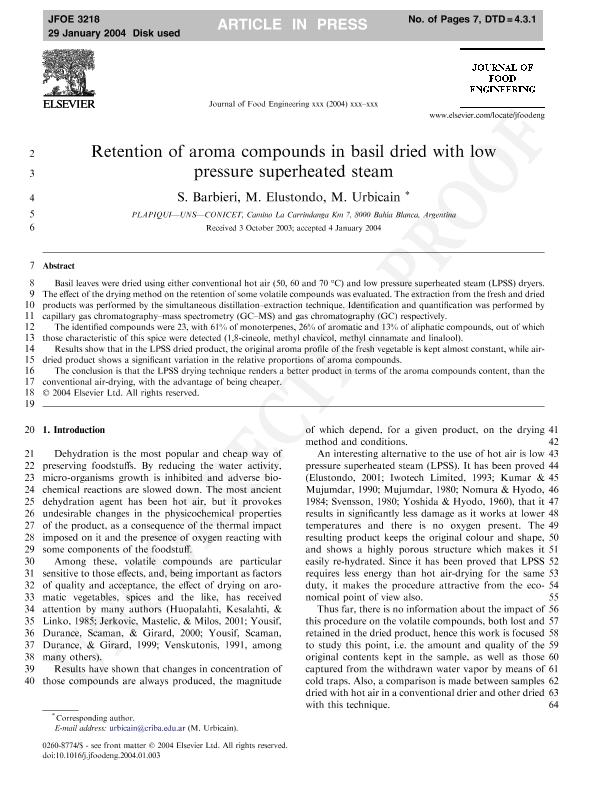Mostrar el registro sencillo del ítem
dc.contributor.author
Barbieri, S.
dc.contributor.author
Elustondo, M.
dc.contributor.author
Urbicain, Martin Juan

dc.date.available
2020-02-17T19:07:06Z
dc.date.issued
2004-11
dc.identifier.citation
Barbieri, S.; Elustondo, M.; Urbicain, Martin Juan; Retention of aroma compounds in basil dried with low pressure superheated steam; Elsevier; Journal of Food Engineering; 65; 1; 11-2004; 109-115
dc.identifier.issn
0260-8774
dc.identifier.uri
http://hdl.handle.net/11336/97791
dc.description.abstract
Basil leaves were dried using either conventional hot air (50, 60 and 70 °C) and low pressure superheated steam (LPSS) dryers. The effect of the drying method on the retention of some volatile compounds was evaluated. The extraction from the fresh and dried products was performed by the simultaneous distillation-extraction technique. Identification and quantification was performed by capillary gas chromatography-mass spectrometry (GC-MS) and gas chromatography (GC) respectively. The identified compounds were 23, with 61% of monoterpenes, 26% of aromatic and 13% of aliphatic compounds, out of which those characteristic of this spice were detected (1,8-cineole, methyl chavicol, methyl cinnamate and linalool). Results show that in the LPSS dried product, the original aroma profile of the fresh vegetable is kept almost constant, while air-dried product shows a significant variation in the relative proportions of aroma compounds. The conclusion is that the LPSS drying technique renders a better product in terms of the aroma compounds content, than the conventional air-drying, with the advantage of being cheaper.
dc.format
application/pdf
dc.language.iso
eng
dc.publisher
Elsevier

dc.rights
info:eu-repo/semantics/openAccess
dc.rights.uri
https://creativecommons.org/licenses/by-nc-sa/2.5/ar/
dc.subject.classification
Ingeniería Química

dc.subject.classification
Ingeniería Química

dc.subject.classification
INGENIERÍAS Y TECNOLOGÍAS

dc.title
Retention of aroma compounds in basil dried with low pressure superheated steam
dc.type
info:eu-repo/semantics/article
dc.type
info:ar-repo/semantics/artículo
dc.type
info:eu-repo/semantics/publishedVersion
dc.date.updated
2020-02-13T20:06:56Z
dc.journal.volume
65
dc.journal.number
1
dc.journal.pagination
109-115
dc.journal.pais
Países Bajos

dc.journal.ciudad
Amsterdam
dc.description.fil
Fil: Barbieri, S.. Consejo Nacional de Investigaciones Científicas y Técnicas. Centro Científico Tecnológico Conicet - Bahía Blanca. Planta Piloto de Ingeniería Química. Universidad Nacional del Sur. Planta Piloto de Ingeniería Química; Argentina
dc.description.fil
Fil: Elustondo, M.. Consejo Nacional de Investigaciones Científicas y Técnicas. Centro Científico Tecnológico Conicet - Bahía Blanca. Planta Piloto de Ingeniería Química. Universidad Nacional del Sur. Planta Piloto de Ingeniería Química; Argentina
dc.description.fil
Fil: Urbicain, Martin Juan. Consejo Nacional de Investigaciones Científicas y Técnicas. Centro Científico Tecnológico Conicet - Bahía Blanca. Planta Piloto de Ingeniería Química. Universidad Nacional del Sur. Planta Piloto de Ingeniería Química; Argentina
dc.journal.title
Journal of Food Engineering

dc.relation.alternativeid
info:eu-repo/semantics/altIdentifier/doi/https://doi.org/10.1016/j.jfoodeng.2004.01.003
dc.relation.alternativeid
info:eu-repo/semantics/altIdentifier/url/https://www.sciencedirect.com/science/article/pii/S0260877404000044
Archivos asociados
